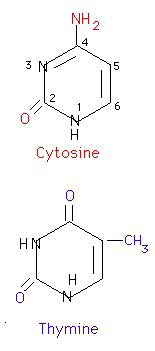2Pyrimidines

Flurouracil (5-FU), normally given by IV administration (oral absorption erratic)
Biotransformed to ribosyl- and deoxyribosyl- derivatives.
Mechanism of Action:
One derivative, 5-fluoro-2'-deoxyuridine 5'-phosphate (FdUMP), inhibits thymidylate synthase and its cofactor,a tetrahydrofolate derivative, resulting in inhibition of thymidine nucleotide synthesis.
Another derivative, 5-fluorouridine triphosphate is incorporated into RNA, interfering with RNA function.
Cytotoxicity:effects on both RNA and DNA
Clinical Use: Systemically -- adenocarcinomas; Topically: skin cancer
Floxuridine (FUDR): similar to 5-FU, used for hepatic artery infusion.
Major Toxicity: myelosuppression, mucositis.
Cytarabine (ara-C) IV administration
Mechanism of Action:S phase-specific antimetabolite
Biotransformed to active forms: ara-CTP, competitive inhibitor of DNA polymerase.
Blocks DNA synthesis; no effect on RNA or protein synthesis
cytarabine incorporated into RNA and DNA -- interfering with chain elongation
Clearance: deamination (inactive form)
S phase specificity: highly schedule-dependent
Clinical Use: almost exclusively for acute myelogenous leukemia
Adverse Effects:
nausea
alopecia
stomatitis
severe myelosuppression
Azacitidine (IV administration):
Mechanism of Action: active derivatives inhibit orotidylate decarboxylase -- reducing pyrimidine nucleotide synthesis; azacitidine -- incorporated into DNA and RNA; inhibits DNA, RNA, and protein synthesis.
Investigational drug -- second-line agent in treatment of acute leukemia
Adverse Effect: myelosuppression.